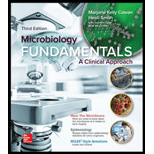
Microbiology Fundamentals: A Clinical Approach
3rd Edition
ISBN: 9781259709227
Author: Marjorie Kelly Cowan Professor, Heidi Smith
Publisher: McGraw-Hill Education
expand_more
expand_more
format_list_bulleted
Question
Chapter 6.1, Problem 1NP
Summary Introduction
Introduction:
The mode of nutrition is an important classification among bacteria. On the basis of the source of energy and carbon source the organisms are classified into two major categories autotrophs and heterotrophs. Autotrophs use the sunlight, organic and inorganic sources as energy sources and CO2 as the carbon source, heterotrophs on the other hand use organic matter as the source of energy as well as the carbon source.
Expert Solution & Answer
Want to see the full answer?
Check out a sample textbook solution
Students have asked these similar questions
What is the label ?
Can you described the image? Can you explain the question as well their answer and how to get to an answer to an problem like this?
glg 112 mid unit assignment Identifying melting processes
Chapter 6 Solutions
Microbiology Fundamentals: A Clinical Approach
Ch. 6.1 - List the essential nutrients of a bacterial cell.Ch. 6.1 - Prob. 2AYPCh. 6.1 - List and define four different terms that describe...Ch. 6.1 - Prob. 4AYPCh. 6.1 - Compare and contrast the processes of diffusion...Ch. 6.1 - Identify the effects of isotonic, hypotonic, and...Ch. 6.1 - Name two types of passive transport and one type...Ch. 6.1 - Prob. 1NPCh. 6.1 - Prob. 2NPCh. 6.1 - Prob. 3NP
Ch. 6.1 - Prob. 1MMCh. 6.2 - List and define five terms used to express the...Ch. 6.2 - Summarize three ways in which microorganisms...Ch. 6.2 - Identify three important environmental factors...Ch. 6.2 - List and describe the five types of associations...Ch. 6.2 - Discuss characteristics of biofilms that...Ch. 6.2 - Which statements are true with respect to...Ch. 6.3 - Summarize the steps of cell division used by most...Ch. 6.3 - Define doubling time, and describe how it leads to...Ch. 6.3 - Compare and contrast the four phases of growth in...Ch. 6.3 - Identify one culture-based and one...Ch. 6.3 - Prob. 2MMCh. 6 - Which descriptors are likely to have applied to...Ch. 6 - Prob. 2QCh. 6 - Speculate about how earths atmosphere came to...Ch. 6 - Which of the following is true of passive...Ch. 6 - Compare the effects of a hypertonic, hypotonic,...Ch. 6 - Usually scientists looking for life on other...Ch. 6 - An organism that can synthesize all its required...Ch. 6 - Provide evidence in support of or refuting this...Ch. 6 - Develop an explanation for why biofilm bacteria...Ch. 6 - Most bacteria increase their numbers by a. sexual...Ch. 6 - Looking at figure 6.3, explain how a cell in a...Ch. 6 - In binary fission, the parent chromosome is...Ch. 6 - A cell exposed to a hypertonic environment will...Ch. 6 - Prob. 14QCh. 6 - Bacteria and archaea are ubiquitous on the planet....Ch. 6 - Prob. 16QCh. 6 - How can you explain the fact that an unopened...Ch. 6 - Prob. 18QCh. 6 - In a viable count, each ____ represents a ______...Ch. 6 - If an egg salad sandwich sitting in a car on a...Ch. 6 - Scientists now believe that most bacteria in...Ch. 6 - Prob. 1VC
Knowledge Booster
Learn more about
Need a deep-dive on the concept behind this application? Look no further. Learn more about this topic, biology and related others by exploring similar questions and additional content below.Similar questions
- Explain how the hormones of the glands listed below travel around the body to target organs and tissues : Pituitary gland Hypothalamus Thyroid Parathyroid Adrenal Pineal Pancreas(islets of langerhans) Gonads (testes and ovaries) Placentaarrow_forwardWhat are the functions of the hormones produced in the glands listed below: Pituitary gland Hypothalamus Thyroid Parathyroid Adrenal Pineal Pancreas(islets of langerhans) Gonads (testes and ovaries) Placentaarrow_forwardDescribe the hormones produced in the glands listed below: Pituitary gland Hypothalamus Thyroid Parathyroid Adrenal Pineal Pancreas(islets of langerhans) Gonads (testes and ovaries) Placentaarrow_forward
- Please help me calculate drug dosage from the following information: Patient weight: 35 pounds, so 15.9 kilograms (got this by dividing 35 pounds by 2.2 kilograms) Drug dose: 0.05mg/kg Drug concentration: 2mg/mLarrow_forwardA 25-year-old woman presents to the emergency department with a 2-day history of fever, chills, severe headache, and confusion. She recently returned from a trip to sub-Saharan Africa, where she did not take malaria prophylaxis. On examination, she is febrile (39.8°C/103.6°F) and hypotensive. Laboratory studies reveal hemoglobin of 8.0 g/dL, platelet count of 50,000/μL, and evidence of hemoglobinuria. A peripheral blood smear shows ring forms and banana-shaped gametocytes. Which of the following Plasmodium species is most likely responsible for her severe symptoms? A. Plasmodium vivax B. Plasmodium ovale C. Plasmodium malariae D. Plasmodium falciparumarrow_forwardStandard Concentration (caffeine) mg/L Absorbance Reading 10 0.322 20 0.697 40 1.535 60 2.520 80 3.100arrow_forward
arrow_back_ios
SEE MORE QUESTIONS
arrow_forward_ios
Recommended textbooks for you
 Biology: The Dynamic Science (MindTap Course List)BiologyISBN:9781305389892Author:Peter J. Russell, Paul E. Hertz, Beverly McMillanPublisher:Cengage Learning
Biology: The Dynamic Science (MindTap Course List)BiologyISBN:9781305389892Author:Peter J. Russell, Paul E. Hertz, Beverly McMillanPublisher:Cengage Learning Biology: The Unity and Diversity of Life (MindTap...BiologyISBN:9781305073951Author:Cecie Starr, Ralph Taggart, Christine Evers, Lisa StarrPublisher:Cengage Learning
Biology: The Unity and Diversity of Life (MindTap...BiologyISBN:9781305073951Author:Cecie Starr, Ralph Taggart, Christine Evers, Lisa StarrPublisher:Cengage Learning



Biology: The Dynamic Science (MindTap Course List)
Biology
ISBN:9781305389892
Author:Peter J. Russell, Paul E. Hertz, Beverly McMillan
Publisher:Cengage Learning


Biology: The Unity and Diversity of Life (MindTap...
Biology
ISBN:9781305073951
Author:Cecie Starr, Ralph Taggart, Christine Evers, Lisa Starr
Publisher:Cengage Learning

Biochemical Tests-Part 1; Author: Southern Stacker;https://www.youtube.com/watch?v=a-i9vANfQWQ;License: Standard Youtube License